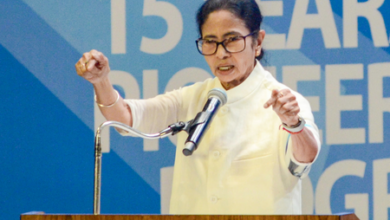
Bengaluru, Aug 12: Incessant rain caused havoc and disrupted life in IT city Bengaluru on Monday with waterlogging and flooding affecting the low-lying areas most, and prompting the BJP to highlight the Siddaramaiah’s government’s ‘mismanagement’.
Bengaluru South MP and BJP Yuva Morcha National President Tejasvi Surya took to X, and said, “The water logging and flooding in Bengaluru, after a few hours of rain in the early morning, once again exposes the absence of municipal leadership in the city. Brand Bengaluru stands for Technology Innovation, unmatched talent pool and rich local culture. Sadly, only the traffic, water logging, potholes and garbage management issues seem to be marking our brand.”
Surya said, “I had highlighted how the city lacks a directly-elected mayor with a workable term of 3-5 years who can be held accountable for the city’s urban infra. Global cities like London, New York and Paris have such strong powerful mayors looking solely into the city’s needs. Forget a Mayor. Bengaluru, at the moment, does not even have Corporators and the common citizen is forced to reach out to the unapproachable BBMP officials or only vent one’s frustration on social media,” he stated.
“For long, we have implemented band-aid solutions to Bengaluru’s traffic problem and poor urban infra, instead of approaching it from the perspective of a well-structured town planning body. Such solutions only fix the symptom and is not the remedy for the problem itself,” he opined.
Urban spaces elsewhere are also characterized by walkable footpaths, layout gardens and strictly governed traffic and parking rules — giving pedestrians and public transport the uttermost prominence, he stated.
“Metro, suburban railway and bus system have to complement one another and the Bengaluru Metropolitan Land Transport Authority (BMLTA) was a step in the right direction. The current government has neither taken any step to form the BMLTA nor has it delegated traffic engineers any power to plan the traffic management of the city. Unless we take up town planning and rework on our layouts, Brand Bengaluru will remain a dream. Bengaluru deserves better,” the BJP MP said.
Meanwhile, a yellow alert has been issued by the India Meteorological Department for a week for Bengaluru and south interior Karnataka districts. Heavy rain was predicted in Bengaluru Urban, Bengaluru Rural, Chamarajanagar, Chikkaballapur, Kolar and Bengaluru South districts.
The authorities, who are busy clearing waterlogged areas across the city, are crossing their fingers over heavy rain prediction.
The rain continued to lash the coastal Karnataka region.
–IANS






